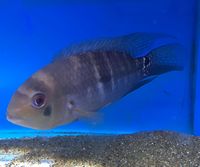Black Acara (Cichlasoma portalegrense)
From The Aquarium Wiki
Revision as of 11:46, 25 January 2021 by 51.148.165.189 (talk)
Cichlasoma portalegrense
170 Litres (45 US G.)
20.3-25.4cm (8-10 ")
Freshwater
6.0 - 8.0
16.1-22.8°C (61 -73 °F)
2-18 °d
1:1 M:F
6-10 years
Family
Cichlidae
Contents
Additional names
- Black Acara, Port Acara, Red Port Acara, Brown Acara
Additional scientific names
- Acara minuta, Acara portalegrensis, Aequidens portalegrensis
Sexing[edit]
- The males tend to be larger. Also an easily identifiable way to tell a male's anal and dorsal fins are extended and will start to curve around the tail towards maturity and will continue till the end of their lifespan.
Breeding[edit]
- Port or the Black Acara's can begin breeding at about 7.6-10.2cm (3-4"). Usually you might not notice the breeding process the first time until you see the fry appear. They can lay anywhere from 200-600 eggs at once. They will lay them on a flat clean surface, anything from a rock to a sunken leaf. They are able to breed several times a year, a PH of 7 will help and frequent partial water changes encourage breeding. Also a higher temperature of 24.4-26.7°C (76-80°F) will help initiate breeding.
- The fry hatch after about four days and then are free swimming after another four. The parents will guard them for a week or two moving them to pits in the gravel around the tank. After about three weeks of the breeding process or if the fry are taken out, the female will be ready to breed again. You can start feeding the fry on rotifers, baby brine shrimp, or a commercial fry fish food. After about 4 months or less the fry will be about an 2.5cm (1") and you can feed on flake food.
Tank compatibility[edit]
- A territorial, yet generally peaceful Cichlid. Do not keep with very small fish nor multiple males as they will argue over territories. Should be otherwise peaceful towards tank mates.
Diet[edit]
- Not a fussy eater by far. These Cichlids will munch on just about anything you feed them, they do well on Cichlid pellets, flakes, bloodworm and will even chew and carry algae disks around the tank. To keep them the healthiest and the largest, provide a variety of foods, even the occasional live feeder.
Feeding regime[edit]
- Feed whenever necessary. Usually 1-3 times a day depending on size if you're gut loading them, 1-2 times a day on normal basis.
Environment specifics[edit]
- This fish does well in a tank of at least 151 Litres (40 US G.) or more, at least 91.4cm (36") in length. These fish will dig in the substrate, so any plants should either be potted or very well rooted, and any other heavy décor that may be knocked over. They prefer a gravel substrate and dimly lit tanks or tanks with floating plants. There should be an even amount of open swimming space and hiding places.
Behaviour[edit]
- A semi-aggressive Cichlid, won't cause any real harm to small fish as long as it can't fit in their mouth. Mostly just territorial, will claim part of the tank and defend it, and they become very territorial when spawning and will take over a large portion if not 90 percent of the tank as theirs. Will squabble but not readily. For the most part a peaceful Cichlid that can be kept in a semi-community set-up with either larger Cichlids to medium tetra's. Shouldn't be paired with over large aggressive fish. A good eater and easily taken care of. Will tend to burrow so have well rooted plant, or keep in pots or with larger stones around the base.
Identification[edit]
- A darker rounder Cichlid. Can be identified by their darker greyish, to grey-green to grey-blue. Males tend to be more greenish-blue why females tend to be browner. Has somewhat of an iridescence to the fish in good lighting. Also has a bold mid-lateral line that extends from the eye to the caudal fin but may be reduced to large spots. Will turn a white-ish yellow colour with a hue of green depending on mood.
Pictures[edit]
External links[edit]
- Fishbase (Mirrors:
 )
)
